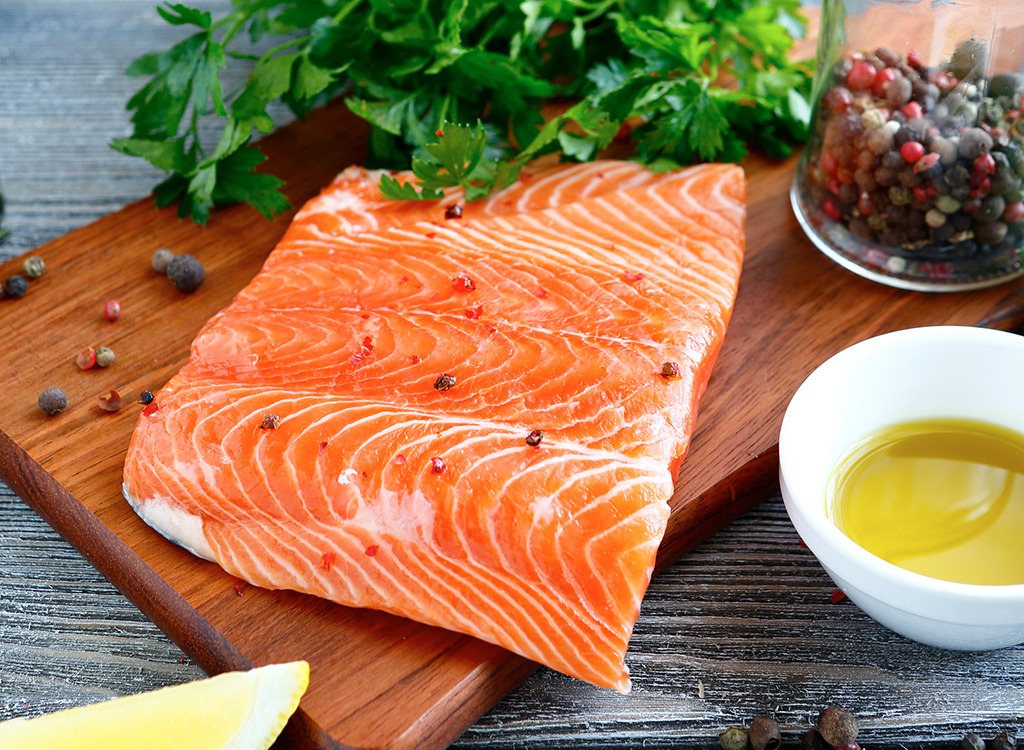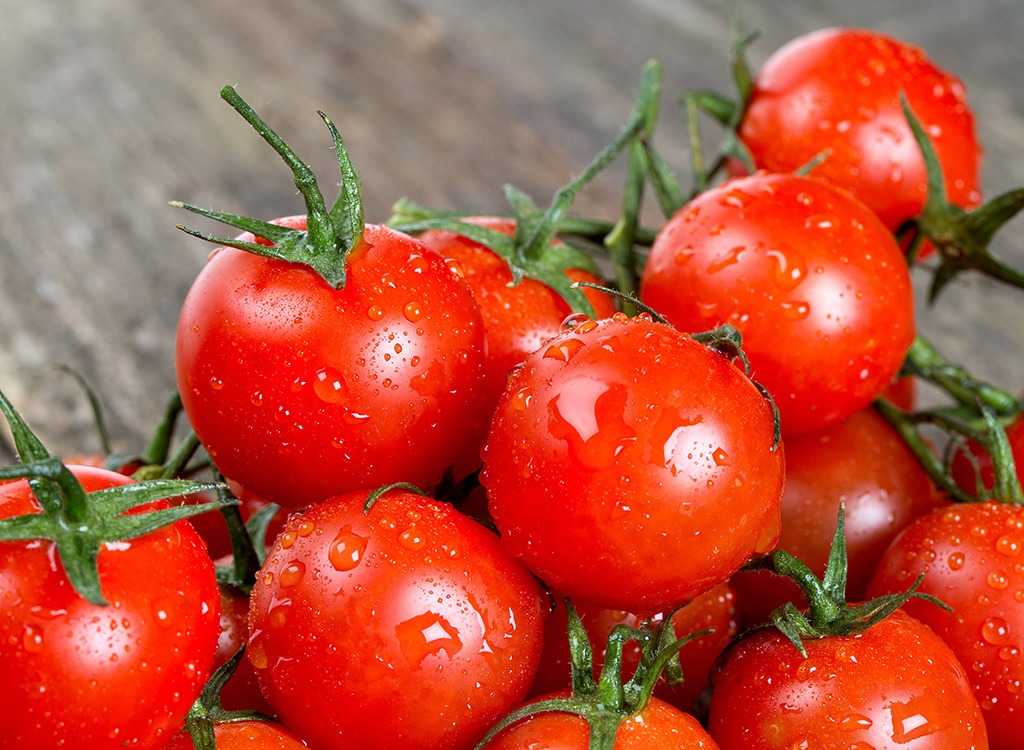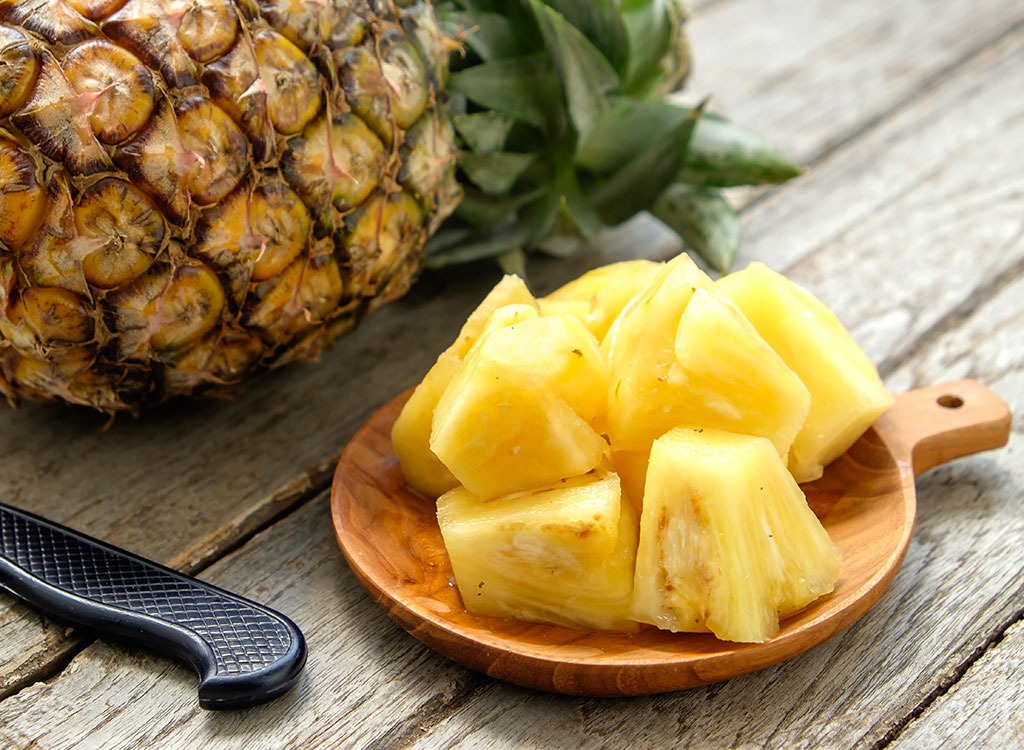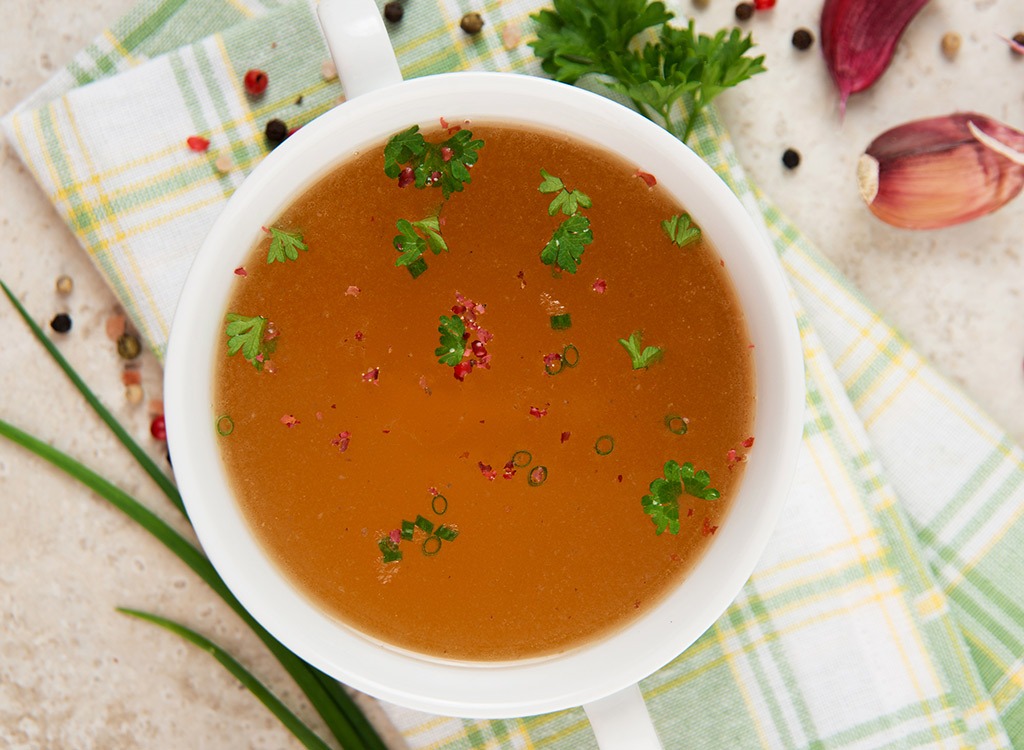Inflammation works a little like sports fans at their team’s championship game; one minute they’re cheering along in the stands. But once the final buzzer goes off to signify their victory, they’re flooding the court in an unstoppable wave—then setting cars ablaze while rioting in the streets. And just like a harmless movement can balloon into one with disastrous and dangerous outcomes, inflammation’s healing intentions can also get out of hand and ultimately translate into the menacing consequence of sickness and weight gain.
Part of your body’s immune response, inflammation in the body is essentially your body’s way of alerting you when you experience an injury or wound. For example, after spraining your ankle, it will likely start to swell and throb. Although painful, this physiological reaction occurs to signal your immune system to fix it. It’s not just external injuries that cause inflammation, however. Things like a lack of sleep, excessive stress, genetics, and—what might be worst of all—the wrong diet can all contribute to inflammation.
How diet can contribute to inflammation
By “wrong diet,” we’re talking about the typical American diet, which is full of inflammation-inducing foods. Think: fried foods, refined flours and sugars, hormone- and antibiotic-laden animal products, synthetic sweeteners, and artificial food additives. So if you’re constantly noshing on these items, your body may begin to transition into a state of chronic inflammation. This inflammatory, high-energy diet reduces levels of gut-healthy probiotics, induces weight gain, and has been connected with a host of diseases, from diabetes and obesity, to heart disease and cancer.
So, if you’ve been struggling to lose weight, and you’ve continued to eat the same foods (yes, even if you are eating less of them), it’s time for a change. And science has an answer for you. Researchers are proving that fitting in certain foods into your diet may help to counteract the effects of inflammation-perpetuated weight gain. These healing foods attack inflammation by increasing the concentration of beneficial bacteria in your gut, turning off inflammatory genes, and decreasing levels of pro-inflammatory biomarkers—many of which will torch fat in the process.
Fit these anti-inflammatory foods into your diet, and you’ll be on your way to a leaner, happier you. Then, for more healthy eating tips, make sure to check out 6 Superfoods That Can Help Slow Aging After 40.


A deliciously balanced anti-inflammatory food is a tart cherry, also known as a Montmorency cherry. says Amy Goodson, MS, RD, CSSD, LD author of The Sports Nutrition Playbook and member of our Expert Medical Board,
“Tart cherries contain anthocyanins, which are anti-inflammatory compounds that may help combat chronic diseases,” says Amy Goodson, MS, RD, CSSD, LD author of The Sports Nutrition Playbook and member of our Expert Medical Board. “Research suggests tart cherries may help reduce arthritis pain and can help fight oxidative stress, leading to better recovery after exercise.”


A study in the journal Antioxidants showed that eating berries could significantly reduce inflammation. Why is this exactly? Well, berries contain a class of antioxidants called flavonoids, but it’s the anthocyanins, specifically, that contribute their anti-inflammatory effects by effectively turning off inflammatory and immune genes.
And when it comes to anthocyanins, blueberries are king. On top of that, blueberries contain vitamin C and another polyphenol, resveratrol, which have both been found to promote anti-inflammatory responses through decreasing inflammatory free radicals.


Throw together a jar of overnight oats packed with dark chocolate, berries, nuts, and a dash of cinnamon, and you’ll be fighting inflammation and drastically reducing belly fat. The raw oats are a resistant starch, a type of carb that passes through your gut undigested.
Instead of feeding you, it feeds your healthy gut bacteria, which in turn produce a fatty acid that encourages more efficient fat oxidation known as butyrate. Higher levels of butyrate reduce inflammation in your body and help reduce insulin resistance as well. Less inflammation means less bloating and a slimmer you.


Researchers attribute ginger’s health benefits to gingerols, compounds that are antioxidant, anti-inflammatory, antibacterial, and anti-disease. According to numerous studies, these compounds block several genes and enzymes in the body that promote inflammation.
For instance, according to a study published in Frontiers in Pharmacology, ginger’s can help reduce inflammation in the body by lowering the amount of pro inflammatory cytokines (proteins found in cells) and increasing the number of anti-inflammatory cytokines. Fresh ginger is richest in gingerol, so grate up the root, throw it in a mesh bag, steep, and sip on ginger tea.


Say hello to your secret weight-loss tool: Green tea, a humble drink that’s been cherished as a health miracle for centuries. This tea contains high levels of catechins, the group of antioxidants concentrated in the leaves of tea plants. And the most powerful of all catechins, a compound called epigallocatechin gallate, or EGCG, is found almost exclusively in green tea.
One recent study published in Cochrane Reviews concluded that green tea may be able to aid in weight loss in overweight or obese individuals. According to Anti-Inflammatory & Anti-Allergy Agents in Medicinal Chemistry, green tea—especially with its high content of EGCG—has been found to help fight against inflammatory diseases as well.


Great news for all you chocoholics! A review published in Frontiers in Immunology found that consumption of dark chocolate may positively impact the diversity of the gut microbiome, which in turn would have anti-inflammatory effects. In a small study on participants who had existing type 2 diabetes, researchers discovered that those who ate 30 grams of 84% dark chocolate for a period of eight weeks had fewer inflammatory markers in their blood than the non-chocolate eaters.
To enhance the effects of this anti-inflammatory food, try pairing it with some apple slices. The fruit speeds up the probiotic fermentation process, leading to an even greater reduction in inflammation and weight. You just want to make sure you’re choosing the right kind; look for cacao content of 70% or above because these contain the highest amounts of antioxidants.


When it comes to fats, there’s one variety you definitely don’t want to eat less of: omega-3s! These healthy fats are famous for their anti-inflammatory properties, and fatty fish are one of the best sources of this class of polyunsaturated fats.
For example, wild salmon provides you with both EPA and DHA, two of the main types of omega-3s. And unlike plant omega-3s, these two fatty acids are already in an active form, meaning they’ll more efficiently attack excess inflammation through the increase in adiponectin—a hormone that enhances your muscles’ ability to use carbs for energy, boosts metabolism, and burns fat—which ultimately decrease inflammation markers.


Peppers are an anti-inflammatory superfood—but go red to reap the most benefits. Out of the three colors of bell pepper, red have the highest amount of inflammatory biomarker-reducing vitamin C, along with the bioflavonoids beta-carotene, quercetin, and luteolin, according to research in the Journal of Food Science. Luteolin has been found to neutralize free radicals and reduce inflammation.
Beta-carotene is a carotenoid, fat-soluble compounds that are associated with a reduction in a wide range of cancers, as well as reduced risk and severity of inflammatory conditions such as asthma and rheumatoid arthritis. And allergy research has shown that quercetin acts as a mast-cell stabilizer, which decreases the number of cells reacting to an allergen. Mast cells are responsible for releasing histamine during inflammatory and allergic reactions.


You can thank curcumin for turmeric’s beautifully bright, yellow-orange color—but that’s not all it’s good for. This active compound has been found to contain potent anti-inflammatory and antioxidant properties.
A study in Drug Design, Development and Theory shows curcumin inhibits the activation of inflammatory pathways and limits production of inflammatory markers. For this reason, curcumin has been implicated in a range of beneficial health effects, from preventing cognitive decline, liver damage, and heart disease, while easing joint inflammation and pain associated with arthritis.


Besides being a source of many phytochemicals, including ascorbic acid, carotenoids, and flavonoids, beets are a unique source of betalain pigments, which have been found to display potent antioxidant, anti-inflammatory, and chemopreventive activity. One of these pigments, betaine, is a nutrient that not only fights inflammation, but also is known to rev your metabolism, positively influence the mechanism for insulin resistance, boost your mood, and shut down genes that encourage fat to hang around.
A study in the Journal of Human Hypertension has associated eating beets and beetroot juice with lower levels of inflammatory markers—including CRP as well as interleukin-6 and tumor necrosis factor, which are released by harmful belly fat—as well as a decrease in risk of plaque buildup, high blood pressure, and type 2 diabetes.


Broccoli’s anti-inflammatory benefit could be linked to the sprouts’ glucosinolate content. These compounds help prevent unwanted inflammation when they’re converted to I3C—a compound that research has found to decrease the production of pro-inflammatory mediators on a genetic level. It’s also high in vitamin K, a vitamin found in many cruciferous and leafy green veggies, which can help regulate inflammatory responses in the body. Just don’t nosh on it raw if you have a pollen allergy!


Similar to raw oats, black beans and most other pulses pack a strong resistant-starch punch, providing the source of fuel for you healthy gut bugs to ferment into the inflammation-reducing fatty acid butyrate. A cup of black beans not only packs 3.1 grams of resistant starch, it also carries nearly 15 grams of protein and 15 grams of filling fiber, making black beans a delicious fat-fighting triple threat.
READ RELATED: 7 Strength Exercises for Men To Lose Weight After 40
Not only that, but black beans are high in anthocyanins, which are antioxidants that have been associated with lowering inflammation. According to a 2020 study from the journal Nutrients, eating cooked black beans was linked to greater gut bacteria diversity that led to decreased inflammatory response, as well as improved insulin sensitivity.


Add fighting inflammation to the list of Mediterranean diet benefits—right next to reducing the risk of cardiovascular disease and dialing up weight loss. While researchers initially believed many benefits were conferred by the presence of healthy monounsaturated fats, they also found that other oils with MUFAs, particularly oleic acid, did not exhibit the same health benefits. Researchers have found that a key component is oleocanthal. This compound, found only in extra virgin olive oils (as these are unrefined and contain more phenolic compounds), has a significant impact on inflammation, working similarly to ibuprofen in that it prevents the production of pro-inflammatory COX-1 and COX-2 enzymes.


Tomatoes are a great source of lycopene, an antioxidant that protects your brain and fights depression-causing inflammation. Because lycopene lives in tomato skins, you’ll get more of the stuff if you throw a handful of cherry tomatoes into your next salad instead of slicing up one full-size tomato. Enjoy them with a little olive oil, which has been shown to increase fat-soluble lycopene absorption.


With almost 9 grams of healthy fats (including inflammation-quelling ALA omega-3s) alongside a whopping 9.8 grams of fiber and 4.6 grams of protein per ounce, chia seeds are an inflammation-fighting superfood. The Harvard School of Public Health suggests chia seeds can decrease spikes in blood sugar in a dose-dependent manner. Post-eating blood sugar spikes have been implicated in causing increases in inflammation due to the overproduction of inflammatory free radicals called reactive oxygen species (ROS).


Pineapple contains bromelain, the enzyme which acts as a meat tenderizer as well as a powerful anti-inflammatory. What some experts have noted is that many anti-inflammatory foods act not necessarily by reducing inflammation directly, but by alleviating symptoms that can eventually cause inflammation.
Bromelain has been found to be beneficial in reducing asthmatic symptoms through decreasing the spread of pro-inflammatory metabolites and relieving post-exercise inflammation by helping to repair and resolve muscle soreness through its significant levels of potassium. While all parts of the pineapple contain this magical compound, most of the bromelain in pineapple is in the stem. Because the stem is a little on the tough side, you can blend or juice the core with the sweeter flesh to reap the bloat-beating benefits.


Spinach attacks inflammation from all sides, making it a helpful anti-inflammatory food. It’s rich in carotenoids, and vitamins C, E, and K—all of which have been found to protect the body from pro-inflammatory cytokines. In a study published in Scientific Reports, vitamin E was found specifically to lower inflammatory markers, and one study from Oxidative Medicine and Cellular Longevity found that in women with diabetes, carotenoids played a helpful role in reducing inflammation.


Brown rice, quinoa, millet, and amaranth all are packed with fiber that helps produce butyrate, a fatty acid that turns off genes related to inflammation and insulin resistance. The high B vitamin content of whole grains—which is nearly entirely lost during the refinement process—also helps reduce the inflammatory hormone homocysteine in the body. Not only that, but high-fiber foods also suppress appetite. And, if you eat less, you’re less likely to be taking in more pro-inflammatory foods.


Besides keeping brittle bones at bay, Vitamin D also fends off depression and colds, reduces the risk of certain cancers, and perhaps most importantly, diminishes inflammation. Previous research has found a correlation between vitamin D deficiency and increased levels of pro-inflammatory markers. While your body produces vitamin D whenever your skin is directly exposed to sunlight, if you’ve been finding that you’re glued to your desk more often than you’d like, it might be best to get some vitamin D into your diet as well, and whole eggs are a great solution.


There’s now science to back-up the smelly, cold-busting benefits of garlic. Researchers hypothesize garlic’s cold-fighting power comes from the compound allicin, which blocks enzymes that play a role in bacterial and viral infections. According to a study found in Molecular Nutrition & Food Research, garlic’s organosulfur compounds have metabolic, immune-boosting, and anti-inflammatory benefits. Taking an aged-garlic supplement provides the highest concentration of bioavailable compounds, but fresh garlic can provide subtle benefits as. Just be sure to crush the garlic first to kickstart production of the bioactive allicin compound—it’s just one of our ways to boost the nutrient content of your food.


If you’re someone who loves slurpin’ on oysters, you’ll also love to know that these can be an anti-inflammatory food as well. Like certain other types of seafood, such as salmon, tuna, and mussels, oysters contain omega-3 fatty acids. According to the National Institute of Health, omega-3 fatty acids can help reduce inflammation in a number of ways, such as prohibiting inflammatory cytokines, increasing production of inflammation resolvins, and activating anti-inflammatory transcription factors—just to name a few.


There’s a new anti-inflammatory food in town, and its name is kamut—or Khorasan wheat. This ancient grain boasts more protein gram-for-gram than quinoa, it’s loaded with energy-boosting, muscle-protecting minerals like magnesium, potassium, and iron, and comes complete with an amazing 7 grams of hunger-busting fiber per cup.
Subbing out meat for plant-based vegan foods is a great way to reduce inflammation because animal protein is one of the top sources of inflammatory saturated fats. Plus, a study published in Food Research International found that eating kamut reduces levels of cytokines: compounds that can cause inflammation throughout the body.


Cultivating a proper gut garden is essential for good health, particularly when it comes to fighting inflammation. That’s because your good gut bugs break down foods into anti-inflammatory fatty acids, which can decrease inflammation. And when your gut isn’t healthy, it can’t do this.
Adding cultured, fermented foods—known as probiotics—into your diet can recolonize your gut with beneficial microbes, which can then assist with fending off inflammation. Low-sugar yogurt with live active cultures is one of the most accessible sources of probiotics, but you can also eat kefir, sauerkraut, pickles, kimchi, and cheese.


In order for your probiotic efforts to succeed, you also have to incorporate foods known as prebiotics into your diet. This groups of high-fiber foods provide your gut bacteria with the fuel they need to function and ferment. Apple peels are full of pectin, a natural fruit fiber that a study published in the journal Nutrients found to be powerful enough to support the growth of the beneficial bacteria bifidobacteria and lactobacillus.


Although not as strong as animal-based omega-3s, DHA and EPA, nuts, particularly walnuts, are a great source of a plant-based, anti-inflammatory omega-3 known as ALA. Almonds are one of the best sources of antioxidant vitamin E, which helps protect cells from oxidative damage, a byproduct of inflammation, and hazelnuts contain the highest amount of immuno-protective oleic acid.


According to a 2016 study published in the American Journal of Clinical Nutrition, the most effective omega-3 when it comes to reducing specific markers of inflammation is DHA over EPA. So, how do you get more of the powerful anti-inflammatory food into your diet? It’s easy (and affordable). Just grab a can of light skipjack tuna, which is one of the best sources of the bioactive fatty acid and one of the best anti-inflammatory foods to eat.


It’s not just a staple when you’re marinating your lemon chicken; this flavorful herb is also a powerful anti-inflammatory thanks to its high concentration of antioxidant compounds. Scientists believe the anti-inflammatory activity comes from the presence of carnosic acid and carnosol, two polyphenolic compounds in rosemary, which a study published in the journal BMC Complementary and Alternative Medicine discovered could effectively inhibit the production of pro-inflammatory cytokines. Another study published in the Iranian Journal of Basic Medical Sciences adds that not only is rosemary anti-inflammatory, but it is also neuroprotective, antioxidant, anti-tumorigenic, and antimicrobial.


Don’t dismiss bone broth as just another health fad—there’s solid evidence to back up its rightful place in your anti-inflammatory food diet. To make it, bones are left to simmer in water for an extended period of time, extracting and breaking down their collagen and other nutrients.
Some of that broken down material from the cartilage and tendons is glucosamine, which you may have seen sold as a supplement for arthritis and joint pain,. According to Scientific Reports, glucosamine is known to have anti-inflammatory properties. The stock is also full of anti-inflammatory amino acids, glycine and proline, and the ample levels of gelatin will help rebuild your gut lining to further assist with your anti-inflammatory gut microbes.


If you’ve ever suffered from indigestion after eating, you’re familiar with the importance of digestion enzymes. But there’s another group of enzymes that’s also important to your health, proteolytic enzymes. These enzymes are essential when it comes to modulating the inflammatory response. They do so by helping to break down proteins and cellular debris and clears them out to reduce your body’s immune and inflammatory response.
Raw honey is one of the best sources of these enzymes because (brace yourself) honey is made by bees’ enzyme-rich saliva. Some studies have found honey to be effective in alleviating symptoms of inflammatory diseases, and bonus: the sweetener is also full of anti-inflammatory polyphenols, carotenoids, antioxidants, and vitamins.


Miso packs an anti-inflammatory one-two punch. Not only is it a fermented food, which means it’s rich in probiotic compounds that ferment fibers into anti-inflammatory compounds, but it’s also made from soy.
What’s so special about soy? Several studies have suggested that soy’s isoflavones—estrogen-mimicking compounds—may be powerful anti-inflammatories. In fact, a review of isoflavones published in a 2016 issue of the journal Nutrients concluded that isoflavones reduce inflammation by reducing pro-inflammatory enzyme and cytokine activities. Another study published in the International Journal of Molecular Sciences found that isoflavones had an anti-inflammatory role in chronic degenerative diseases, such as cancer, arthritis, cardiovascular disease, and neurodegenerative diseases.
A previous version of this story was published on April 19, 2016. It has been updated to include additional copy and proofreading revisions, additional research, and updated contextual links.
Source:









